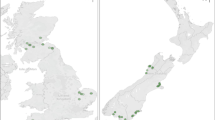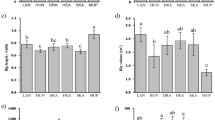Abstract
The enemy release hypothesis (ERH) predicts that introduced species leave most enemies behind during the invasion process, resulting in less enemy damage and increased performance in their introduced range. In Hawai‘i, introduced red mangroves (Rhizophora mangle) convert open shorelines into dense mangrove forests. While previous studies show introduced mangroves harbor a lower occurrence of damage on various plant structures, it remains unknown if the magnitude of damage to mangrove leaves and metrics of performance differ between introduced and native populations. In this study, we tested some of the predictions of the ERH through leaf damage surveys and a year-long damage experiment replicated in 8–10 sites in the native (Caribbean and Florida) and introduced (Hawai‘i) range of red mangroves. In each site, we (1) compared the percentage of leaf area damaged, (2) measured metrics of performance (leaf loss, leaf, twig, and propagule production), and (3) experimentally tested how rapidly necrosis spreads on artificially-damaged leaves of R. mangle. Our results were largely consistent with the ERH. Native mangroves exhibited orders of magnitude higher leaf damage than introduced mangroves, suffered nearly twice the leaf loss, and produced fewer twigs and propagules than introduced mangroves over one year. Leaf production and the expansion of necrotic area on leaves were similar. Broadly, our study demonstrates that introduced mangroves experience substantially less leaf damage and thus, may be exhibiting evidence of increased growth and fecundity. Our results may help explain why introduced mangroves continue to be so productive and are considered invasive in Hawaiian habitats.



Similar content being viewed by others
Data availability
The data for this study are available by contacting the corresponding author.
References
Agrawal AA, Kotanen PM (2003) Herbivores and the success of exotic plants: a phylogenetically controlled experiment. Ecol Lett 6:712–715. https://doi.org/10.1046/j.1461-0248.2003.00498.x
Allen J (1998) Mangroves as alien species: the case of Hawaii. Glob Ecol Biogeogr Lett 7:61–71
Beever J, Simberloff D, King L (1979) Herbivory and predation by the mangrove tree crab Aratus pisonii. Oecologia 43:317–328
Brooks ME, Kristensen K, van Benthem KJ et al (2017) glmmTMB balances speed and flexibility among packages for zero-inflated generalized linear mixed modeling. R J 9:378–400
Burrows D (2003) The role of insect leaf herbivory on the mangroves Avicennia marina and Rhizophora stylosa. Doctoral dissertation, James Cook University
Cannicci S, Burrows D, Fratini S et al (2008) Faunal impact on vegetation structure and ecosystem function in mangrove forests: a review. Aquat Bot 89:186–200. https://doi.org/10.1016/j.aquabot.2008.01.009
Chun YJ, van Kleunen M, Dawson W (2010) The role of enemy release, tolerance and resistance in plant invasions: linking damage to performance. Ecol Lett 13:937–946. https://doi.org/10.1111/j.1461-0248.2010.01498.x
Colautti RI, Ricciardi A, Grigorovich IA, MacIsaac HJ (2004) Is invasion success explained by the enemy release hypothesis? Ecol Lett 7:721–733. https://doi.org/10.1111/j.1461-0248.2004.00616.x
Coley PD, Barone JA (1996) Herbivory and plant defenses in tropical forests. Annu Rev Ecol Syst 27:305–335
Cox EF, Allen JA (1999) Stand structure and productivity of the introduced Rhizophora mangle in Hawaii. Estuaries 22:276–284. https://doi.org/10.2307/1352983
Creager DB (1962) A new Cercospora on Rhizophora mangle. Mycologia 54:536–539. https://doi.org/10.1080/00275514.1962.12025033
Davidson TM, Smith CM, Torchin ME (2022) Introduced mangroves escape damage from marine and terrestrial enemies. Ecology 103:e3604. https://doi.org/10.1002/ecy.3604
Demopoulos AWJ, Smith CR (2010) Invasive mangroves alter macrofaunal community structure and facilitate opportunistic exotics. Mar Ecol Prog Ser 404:51–67. https://doi.org/10.3354/meps08483
Demopoulos AWJ, Fry B, Smith CR (2007) Food web structure in exotic and native mangroves: a Hawaii–Puerto Rico comparison. Oecologia 153:675–686. https://doi.org/10.1007/s00442-007-0751-x
Ellison AM, Farnsworth EJ (1993) Seedling survivorship, growth, and response to disturbance in Belizean mangal. Am J Bot 80:1137–1145. https://doi.org/10.1002/j.1537-2197.1993.tb15345.x
Ellison AM, Farnsworth EJ (1996) Spatial and temporal variability in growth of Rhizophora mangle saplings on coral cays: links with variation in insolation, herbivory, and local sedimentation rate. J Ecol 84:717–731. https://doi.org/10.2307/2261334
Erickson AA, Bell SS, Dawes CJ (2012) Associational resistance protects mangrove leaves from crab herbivory. Acta Oecol 41:46–57. https://doi.org/10.1016/j.actao.2012.04.002
Erickson AA, Saltis M, Bell SS, Dawes CJ (2003) Herbivore feeding preferences as measured by leaf damage and stomatal ingestion: a mangrove crab example. J Exp Mar Biol Ecol 289:123–138. https://doi.org/10.1016/S0022-0981(03)00039-X
Farnsworth EJ, Ellison AM (1991) Patterns of herbivory in Belizean mangrove swamps. Biotropica 23:555–567. https://doi.org/10.2307/2388393
Farnsworth EJ, Ellison AM (1993) Dynamics of herbivory in Belizean mangal. J Trop Ecol 9:435–453
Fazlioglu F, Chen L (2020) Introduced non-native mangroves express better growth performance than co-occurring native mangroves. Sci Rep 10:3854. https://doi.org/10.1038/s41598-020-60454-z
Feller IC (1995) Effects of nutrient enrichment on growth and herbivory of dwarf red mangrove (Rhizophora mangle). Ecol Monogr 65:477–505. https://doi.org/10.2307/2963499
Feller IC, Chamberlain A (2007) Herbivore responses to nutrient enrichment and landscape heterogeneity in a mangrove ecosystem. Oecologia 153:607–616. https://doi.org/10.1007/s00442-007-0760-9
Feller IC, Mathis W (1997) Primary herbivory by wood-boring insects along an architectural gradient of Rhizophora mangle. Biotropica 29:440–451
Feller IC, McKee K (1999) Small gap creation in Belizean mangrove forests by a wood–boring insect. Biotropica 31:607–617
Fox J, Weisberg S (2019) An R companian to applied regression, 3rd edn. Sage, Thousand Oaks
Gilbert GS, Mejía-Chang M, Rojas E (2002) Fungal diversity and plant disease in mangrove forests: salt excretion as a possible defense mechanism. Oecologia 132:278–285. https://doi.org/10.1007/s00442-002-0966-9
Gill AMA, Tomlinson PB (1969) Studies on the growth of red mangrove (Rhizophora mangle L.) I. Habit and General Morphology. Biotropica 1:1–9
Hartig F (2022) DHARMa: Residual diagnostics for hierarchical (multi-level/mixed) regression models. R package version 0.4.6
Heger T, Jeschke JM (2014) The enemy release hypothesis as a hierarchy of hypotheses. Oikos 123:741–750. https://doi.org/10.1111/j.1600-0706.2013.01263.x
Ho WH, Hyde KD (1996) Pterosporidium gen.nov. to accommodate two species of Anthostomella from mangrove leaves. Can J Bot 74:1826–1829. https://doi.org/10.1139/b96-219
Keane RM, Crawley MJ (2002) Exotic plant invasions and the enemy release hypothesis. Trends Ecol Evol 17:164–170. https://doi.org/10.1016/S0169-5347(02)02499-0
Kohlmeyer J, Bebout B (1986) On the occurrence of marine fungi in the diet of Littorina angulifera and observations on the behavior of the periwinkle. Mar Ecol 7:333–343. https://doi.org/10.1111/j.1439-0485.1986.tb00168.x
Kotanen PM (2020) Direct and indirect effects of herbivores influencing plant invasions. In: Traveset A, Richardson D (eds) Plant invasions: the role of biotic interactions. CABI, Wallingford, pp 226–240
Krauss KW, Lovelock CE, McKee KL et al (2008) Environmental drivers in mangrove establishment and early development: a review. Aquat Bot 89:105–127. https://doi.org/10.1016/j.aquabot.2007.12.014
Lenth RV (2022) emmeans: estimated marginal means, aka least-squares means. R package version 1.8.2
Liu H, Stiling P (2006) Testing the enemy release hypothesis: a review and meta-analysis. Biol Invass 8:1535–1545. https://doi.org/10.1007/s10530-005-5845-y
Liu M-C, Dong T-F, Feng W-W et al (2022) Leaf trait differences between 97 pairs of invasive and native plants across China: effects of identities of both the invasive and native species. NeoBiota 71:1–22. https://doi.org/10.3897/neobiota.71.71385
Marquis RJ (1992) A bite is a bite is a bite? Constraints on response to folivory in Piper arieianum (piperaceae). Ecology 73:143–152. https://doi.org/10.2307/1938727
Meijer K, Schilthuizen M, Beukeboom L, Smit C (2016) A review and meta-analysis of the enemy release hypothesis in plant-herbivorous insect systems. PeerJ 2016:1–15. https://doi.org/10.7717/peerj.2778
Menezes LFT, Peixoto AL (2009) Leaf damage in a mangrove swamp at Sepetiba Bay, Rio de Janeiro, Brazil. Braz J Bot 32:715–724. https://doi.org/10.1590/S0100-84042009000400010
Mitchell CE, Power AG (2003) Release of invasive plants from fungal and viral pathogens. Nature 421:625–627. https://doi.org/10.1038/nature01317
Odum WE, Heald EJ (1975) The detritus-based food web of an estuarine mangrove community. In: Estuarine research: chemistry, biology, and the estuarine system. Elsevier, Amsterdam, pp 265–286
Olexa MT (1976) Distribution, etiology, and importance of red mangrove diseases in Florida. Dissertation, University of Florida
Onuf C, Teal J, Valiela I (1977) Interactions of nutrients, plant growth and herbivory in a mangrove ecosystem. Ecology 58:514–526
Parker JD, Torchin ME, Hufbauer RA et al (2013) Do invasive species perform better in their new ranges? Ecology 94:985–994. https://doi.org/10.1890/12-1810.1
Prior KM, Powell THQ, Joseph AL, Hellmann JJ (2015) Insights from community ecology into the role of enemy release in causing invasion success: the importance of native enemy effects. Biol Invas 17:1283–1297. https://doi.org/10.1007/s10530-014-0800-4
R Core Team (2022) R: a language and environment for statistical computing. Version 4.2.2
Rossi RE, Archer SK, Giri C, Layman CA (2020) The role of multiple stressors in a dwarf red mangrove (Rhizophora mangle) dieback. Estuar Coast Shelf Sci 237:106660. https://doi.org/10.1016/j.ecss.2020.106660
Schielzeth H, Dingemanse NJ, Nakagawa S et al (2020) Robustness of linear mixed-effects models to violations of distributional assumptions. Methods Ecol Evol 11:1141–1152. https://doi.org/10.1111/2041-210X.13434
Siple MC, Donahue MJ (2013) Invasive mangrove removal and recovery: food web effects across a chronosequence. J Exp Mar Biol Ecol 448:128–135. https://doi.org/10.1016/j.jembe.2013.06.008
Smith T (1993) Forest structure. In: Robertson A, Alongi D (eds) Tropical mangrove ecosystems. American Geophysical Union, Washington, DC, pp 101–136
Steele O, Ewel K, Goldstein G (1999) The importance of propagule predation in a forest of nonindigenous mangrove trees. Wetlands 19:705–708
Sweetman AK, Middelburg JJ, Berle AM et al (2010) Impacts of exotic mangrove forests and mangrove deforestation on carbon remineralization and ecosystem functioning in marine sediments. Biogeosciences 7:2129–2145. https://doi.org/10.5194/bg-7-2129-2010
Torchin ME, Mitchell CE (2004) Parasites, pathogens, and invasions by plants and animals. Front Ecol Environ 2:183–190. https://doi.org/10.1890/1540-9295(2004)002[0183:PPAIBP]2.0.CO;2
Van Kleunen M, Weber E, Fischer M (2010) A meta-analysis of trait differences between invasive and non-invasive plant species. Ecol Lett 13:235–245. https://doi.org/10.1111/j.1461-0248.2009.01418.x
Volkmann-Kohlmeyer B, Kohlmeyer J (1993) Biogeographic observations on pacific marine fungi. Mycologia 85:337–346. https://doi.org/10.2307/3760692
Westoby M, Falster DS, Moles AT et al (2002) Plant ecological strategies: some leading dimensions of variation between species. Annu Rev Ecol Syst 33:125–159. https://doi.org/10.1146/annurev.ecolsys.33.010802.150452
Xu M, Mu X, Zhang S et al (2021) A global analysis of enemy release and its variation with latitude. Glob Ecol Biogeogr 30:277–288. https://doi.org/10.1111/geb.13229
Acknowledgements
We wish to acknowledge the field and lab assistance provided by Danielle Nestler, Taylor Jackson, Jessica Agajan, Anthony Ziba, Jill Schmid, Andrew Sellers, Carmen Schloeder, and Nicole Yamase. Rafael Diaz provided helpful statistical advice and Candy Feller provided useful information on herbivory patterns in mangroves. Site access and logistical support was provided by the Smithsonian Tropical Research Institute Bocas del Toro Research Station, Rookery Bay National Estuarine Research Reserve, U.S. Navy at Pearl Harbor, Ka Honua Momona, Mālama Hulē‘ia, Paepae o Heʻeia, Outfitters Kauai, the Vernon family, Charlie Cobb-Adams, the Kalipi family, Herbert and Simone Kollmann, and the Toledo Institute for Development and Environment in Punta Gorda. We also thank Dr. Amanda MF Davidson and two anonymous reviewers for providing feedback that improved previous versions of our manuscript. This work was funded by the National Science Foundation (OCE-1323429 to TMD) and the Sacramento State Research and Creative Activities program (to TMD). This is publication number 195 from the School of Life Sciences, University of Hawaiʻi at Mānoa.
Funding
Funding was provided by the National Science Foundation (OCE-1323429 to TMD) and the Sacramento State Research and Creative Activities program (to TMD).
Author information
Authors and Affiliations
Contributions
All authors contributed to the study conception and design. Data collection and analysis was conducted by Timothy M Davidson. Davidson wrote the first draft of the paper and all authors edited and developed previous versions of the manuscript. All authors have read and approve of the final manuscript.
Corresponding author
Ethics declarations
Conflict of interest
The authors declare no conflict of interests.
Additional information
Publisher's Note
Springer Nature remains neutral with regard to jurisdictional claims in published maps and institutional affiliations.
Supplementary Information
Below is the link to the electronic supplementary material.
Rights and permissions
Springer Nature or its licensor (e.g. a society or other partner) holds exclusive rights to this article under a publishing agreement with the author(s) or other rightsholder(s); author self-archiving of the accepted manuscript version of this article is solely governed by the terms of such publishing agreement and applicable law.
About this article
Cite this article
Davidson, T.M., Torchin, M.E. & Smith, C.M. Introduced mangroves exhibit less leaf damage and greater performance than native mangroves. Biol Invasions 25, 3503–3515 (2023). https://doi.org/10.1007/s10530-023-03120-5
Received:
Accepted:
Published:
Issue Date:
DOI: https://doi.org/10.1007/s10530-023-03120-5




